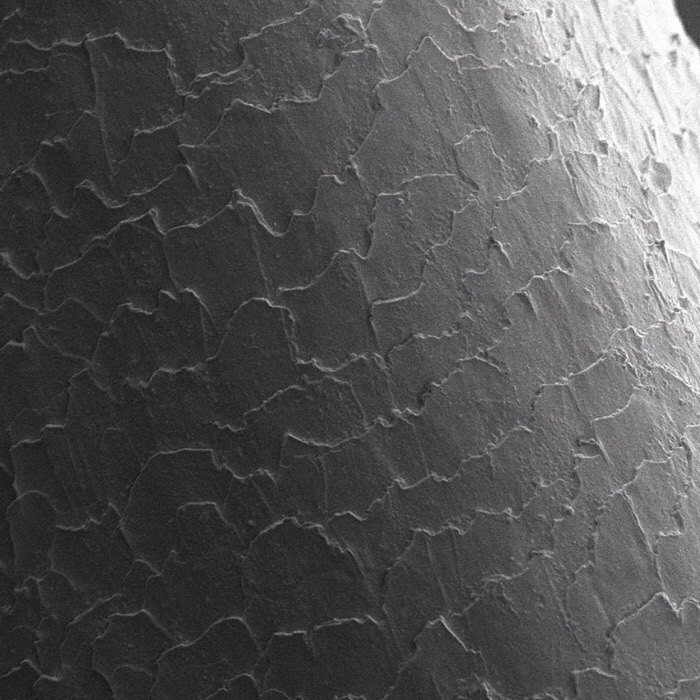
Image Source: Diego Vedita
Rise and shine, academic curlfriends, it’s back-to-school season!
That means you’re either saving up for your own supplies, running around getting your kids’, or in my case, kicking back and enjoying the relative quiet when I go to the arcade on a weeknight.
Either way, we all need to save up! But that doesn’t mean our strands need to suffer.
No matter what your porosity level is, there’s a cost-effective and easy way to keep them moisturized and healthy with just two products and under $20!
But first up, an overview of what porosity is.
This is a microscopic picture snapped of a human hair.

Image Source: Nicola Angeli/MUSE
See that scaly texture it has? That’s the outer cuticle of your hair—kind of like the outer layer of bark on a tree. And this is what determines your porosity level!
Porosity is all about moisture retention, like a door on a sauna. The more raised those scales are, the easier it is for moisture to get out and in. The more tightly they cling to the rest of the hair, the harder it is.
Porosity can be affected by hair treatments, your genetics, damage, and even the weather! But ultimately if it takes more effort to “open and shut” the door, you’ve got higher porosity.
Not sure what your porosity is?
No worries, neither was I for a long time! I was just constantly surprised that not everyone else needed to wipe out an acre of shea plants every year to keep their coils from snapping off their heads.
Take the Texture Quiz here, and pinpoint your porosity level! Then you can come back to this article for the best tips on money-saving curl care.
All set? Great.
If you have low porosity hair…
Use SmartWater and Argan oil.
Normally, I’m opposed to buying “fancy water”, but there’s something about SmartWater’s reverse osmosis whateverness that really helps hair out. The goal here is to keep harder tap water off your hair, so don’t think of it as an expensive water when you reach for it—think of it as a cost-effective hair product! Really, any water that’s not mineral-rich will do, so pass on chalky Fiji if you need an alternative, and look for something that’s been evaporated and “rained” back down.
Argan oil is a lightweight nut oil, and won’t “sit” on top of your closed off strands. Rather, it’ll be able to slip through what few cracks your curls have, and keep things shiny, healthy, and elastic!
If you have medium porosity hair…
Use SheaMoisture’s Coconut leave-in and avocado oil.
Aside from being delicious, creamy, and full of good fats (and I will fight y’all for driving the price up when they got trendy”>, avocados’ seeds also provide a shot of vitamin E to your hair! It’s heavier than argan and apricot, but a little goes a long way as far as sealant.
Because it’s so heavy though, it’s best paired with an actual liquid leave-in. Curlies, it bears repeating, you cannot put oil on dry hair and expect it to sink in. SheaMoisture’s Coconut leave-in helps penetrate further than water, and the medium-weight oil paired with it keeps all that goodness secured in your strands without weighing them down.
If you have high porosity hair…
Use rosewater and JBCO.
Salutations, my open-shaft comrades! High porosity hair needs the most TLC, because not only does moisture leave quickly, the texture of the raised cuticles rubbing against each other can cause breakage just via proximity! Yikes.
Rosewater is a hydrosol, ie, a distilled water made with the soothing floral essence of roses. It’s usually seen as more of a food than a hair treatment, so you’ll find it in the Indian and/or Mediterranean stores in your area, but one bottle will fill up an average sized mister! The same properties that make roses such a softening ingredient for skin also work on your hair! But because our cuticles are naturally raised, it’ll take something much heavier to put them back down.
Jamaican black castor oil is syrupy-thick, and incredibly nourishing. Once it’s on your hair and covered for the night, it’s not going anywhere. That heaviness will keep properly treated hair cuticles closed and smooth for maximum moisture retention!
Why don’t I see a cream in any of these methods?
Well, it wouldn’t be much of a two-step article if I featured three steps…but that’s still a great question!
Whether you LCO or LOC, usually, creams/cremes/puddings/fluffs/anything that’s not see through, but isn’t a natural butter (those count as oils, despite their density”>, cream is usually a part of the curly girl method.
So what gives?
If you’re pressed for time, or staying on budget, a two-step is better than a no-step. That’s really all there is to it, but I’ll still give you the long answer.
If you look at the back of most creams, especially if you’re committed to all nature-made ingredients, you’ll notice the main components are water and oils/butters! Whether the cream is your sealant or your humectant determines what step you add it in your method, and which product you use.
For this two-step, the oil is your sealant, acting to close up your hair shaft, and keep the moisture from step 1 locked in your locks!
However, if you have higher porosity hair like I do, a two-step is best done every day. Even my protective box braids don’t keep my slippage and new growth from drying out if I don’t step up the routine I take with fewer products.
Consider keeping a spray bottle somewhere you can get to it in the afternoon for a touchup, and check in with your curls every evening before bed!
Do you have a no-frills two step method to share, curlfriend? Don’t be shy, save a loc-life and submit your recipes in the comments today!
